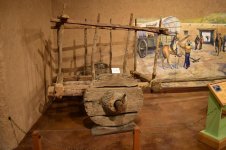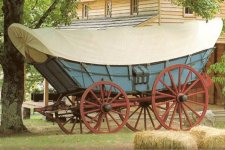OLDNAVYMCPO
US Veteran, Absent Comrade
I've always had a great deal of interest in American history, particularly early American pioneer history. What fascinates me the most is not so much the social or political history but the physical inventiveness and craftsmanship. I have been a craftsman the majority of my life, carpenter, cabinetmaker and welder/ fabricator. That is why I have a real appreciation for well crafted tools and equipment, which is probably why I'm drawn to firearms.
About 40 years ago, I was on my way to Cedar Rapids, Iowa for a construction project. On the way, I passed thru Mason City, Iowa. A highway billboard advertised the Kinney Pioneer Museum. Had to stop. What a great museum. On display were all kinds of early farm equipment and wagons.
Of particular interest to me was a full size replica of a Conestoga wagon. What a remarkable piece of work. Designed in the 1700's by German Mennonites and named for a regional Iroquois tribe of Pennsylvania, the Conestoga was a heavy freight wagon not to be confused with the lighter "prairie schooners" of the Western Expansion. Drawn by mules, horses or oxen, the Conestoga could haul up to 6 tons.
Identified by its high sides, bowed bottom, taut canvas on wooden hoops and removable gates both fore and aft. If properly caulked, the wagon could be floated to cross rivers. The typical size was 18 ft long, 11 ft high and 4 ft wide.
What a remarkable vehicle.
About 40 years ago, I was on my way to Cedar Rapids, Iowa for a construction project. On the way, I passed thru Mason City, Iowa. A highway billboard advertised the Kinney Pioneer Museum. Had to stop. What a great museum. On display were all kinds of early farm equipment and wagons.
Of particular interest to me was a full size replica of a Conestoga wagon. What a remarkable piece of work. Designed in the 1700's by German Mennonites and named for a regional Iroquois tribe of Pennsylvania, the Conestoga was a heavy freight wagon not to be confused with the lighter "prairie schooners" of the Western Expansion. Drawn by mules, horses or oxen, the Conestoga could haul up to 6 tons.
Identified by its high sides, bowed bottom, taut canvas on wooden hoops and removable gates both fore and aft. If properly caulked, the wagon could be floated to cross rivers. The typical size was 18 ft long, 11 ft high and 4 ft wide.
What a remarkable vehicle.


